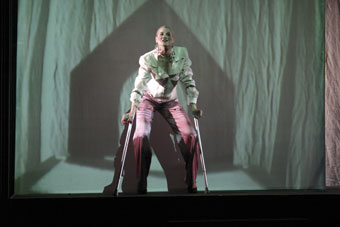The insights of a theatre of excess
Jonathan Marshall

Michelle Fornasier, The Visit
photo Nigel Etherington
Michelle Fornasier, The Visit
Swiss-German playwright Friedrich Dürrenmatt’s (1921-1990) work has recently entered the English language repertoire, much as George Büchner’s did before him. As a result Dürrenmatt’s place within European dramaturgy has been much debated. He is typically identified as reconciling Bertolt Brecht’s political theatre with the moral-cosmic dramas which Martin Esslin proposed as the basis for his existentialist reading of Absurdist theatre. Under this uneasy alliance, Dürrenmatt’s The Visit is placed alongside Eugène Ionesco’s Rhinoceros, their complex meanings being distilled into a critique of the ease with which the individual submits to social pressures and becomes complicit with fascistic aggression, violence and retribution.
The Visit is certainly a moral allegory. The now fabulously wealthy Claire Zachanassian returns to the debilitated town she was driven from as a pregnant and abandoned youth, with no recourse in law to appeal her unjust expulsion. She offers to give the town a billion marks if they kill her former seducer, Alfred Ill. Despite their initial horror, the townspeople gradually succumb and rationalise their decision. But is this all the play has to tell us? That money corrupts, that poverty speaks, that justice is a sham, that few individuals can resist the tide of communal violence, craving and complicity? This is not a new message, now that, as director Jonathan Miller describes it, the “mixture of excrement and edelweiss” which underwrote Austro-German fascism and its lingering aftermath has been repeatedly identified.
In his production for youth company BSX Theatre, director Matthew Lutton does not reject this interpretation. The climax of the staging is the final town meeting in which the schoolmistress–the last to hold out against Ill’s execution–argues with force for its moral necessity. This differs from Simon Phillips’ 2003 Melbourne Theatre Company version, which climaxed with the last, somewhat reconciliatory visit to the woods by Ill and Zachanassian. Phillips rendered Dürrenmatt’s social satire as a humanist drama of love lost. For Lutton, the piece remains a drama of ideas, a portrayal of (sub)human conversion.
Lutton offers more than just dramaturgical doodlings in the textual margins to realise this on stage. His production is non-realist and highly dynamic. A pair of screens at the back are adorned with blown-up images beamed live from a camera resting inside a sad little grey model of Guellen’s railway station suspended from the ceiling above the action. The lack of colour in the image and the station’s hard, blocky architecture suggest indifference and inevitability. Actors periodically retrieve this object and move it forward, before the camera is finally collared about Ill as he commences his death march.
The stage begins awash with clothing, as though a flood of detritus has clouded the theatrical space, before Zachanassian’s arrival reawakens the populace. Zachanassian brings a coffin with her, which periodically grows along with the townspeople’s complicity. Chairs and tables are moved about by the cast to serve as miniature hierarchical stages.
There are other performative flourishes: a pleasing evolution of colour in costuming and make up and open wings where the actors are seen changing. One could ascribe meanings to these motifs, interpreting the central space as a kind of cabaret of moral decay, but in the end there are too many devices to fully cohere. The train arrives in Guellen as a dazzling floodlight is rolled out from behind the rear screens. It passes back and forth several times before Zachanassian’s silhouette steps through. This is a great image, creatively solving the problem of how to represent the train. However, the exaggerated posing of the cast every time it goes past, like refugees from Gustave Munch’s The Scream, is an ostentation on top of an already established sense of doom.
Lutton is not celebrating a sense of theatrical excess or purposelessness, as Daniel Schlusser did with the carnivalesque exaggeration of his 1999 Melbourne production. There is nevertheless a sense of sheer performative invention spilling over the sides of the moral, political and cosmic meaning implied through the spoken text. By staging so much, Lutton makes the production exceed its stated import, performing for us without leaving us quite sure what is being performed. While this may not be intended, Lutton’s overweening theatrical imagination complicates the play sufficiently to add an engrossing sense of unease regarding the now commonplace and hence banal interpretation usually ascribed to The Visit, cutting through these interpretive traditions to suggest something more arresting.
The Visit, writer Friedrich Dürrenmatt, director Matthew Lutton, BSX-Theatre, Melbourne, May 10-28
RealTime issue #67 June-July 2005 pg. 37






